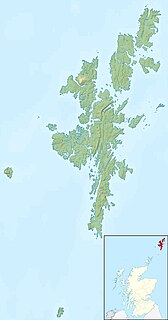
Fair Isle is an island in Shetland, in northern Scotland. It lies about halfway between mainland Shetland and Orkney. It is known for its bird observatory and a traditional style of knitting.
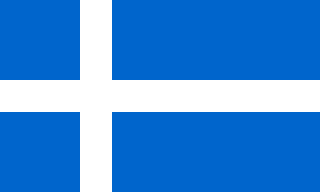
Shetland, also called the Shetland Islands and formerly Zetland, is a subarctic archipelago in the Northern Isles of Scotland, situated in the Northern Atlantic, between Great Britain, the Faroe Islands and Norway.

Bressay Lighthouse is still an active lighthouse in the Shetland Islands, Scotland, 4 kilometres (2.5 mi) south-east of Lerwick. It is located on the island of Bressay at Kirkabister Ness overlooking Bressay Sound.

Lerwick is the main town and port of the Shetland Islands, Scotland. Shetland's only burgh, Lerwick had a population of about 7,000 residents in 2010.

Yell is one of the North Isles of Shetland, Scotland. In the 2011 census it had a usually resident population of 966. It is the second largest island in Shetland after the Mainland with an area of 82 square miles (212 km2), and is the third most populous in the archipelago, after the Mainland and Whalsay.

Bressay is a populated island in the Shetland archipelago of Scotland.

Whalsay is the sixth largest of the Shetland Islands in the north of Scotland.

West Burra is one of the Scalloway Islands, a subgroup of the Shetland Islands in Scotland. It is connected by bridge to East Burra. With an area of 743 hectares (2.87 sq mi), it is the eleventh largest of the Shetland Islands.

The South Shetland Islands are a group of Antarctic islands with a total area of 3,687 square kilometres (1,424 sq mi). They lie about 120 kilometres (75 mi) north of the Antarctic Peninsula, and between 430 kilometres (270 mi) to 900 kilometres (560 mi) south-west from the nearest point of the South Orkney Islands. By the Antarctic Treaty of 1959, the islands' sovereignty is neither recognized nor disputed by the signatories and they are free for use by any signatory for non-military purposes.

South Havra, formerly Hevera, is an uninhabited island in the Scalloway Islands, Shetland, Scotland.
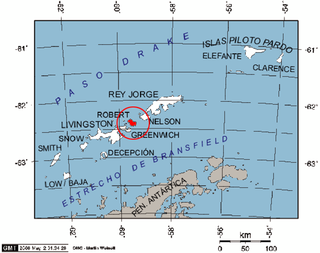
Robert Island or Mitchells Island or Polotsk Island or Roberts Island is an island 11 miles (18 km) long and 8 miles (13 km) wide, situated between Nelson Island and Greenwich Island in the South Shetland Islands, Antarctica. Robert Island is located at 62°24′S59°30′W. Surface area 132 km2 (51 sq mi). The name "Robert Island" dates back to around 1821 and is now established in international usage.

The Shetland Islands Council is the local authority for Shetland, Scotland. It was established by the Local Government (Scotland) Act 1973 and is the successor to the former Lerwick Town Council and Zetland County Council. This council was established in 1975 and was largely unaffected by the Scottish local government changes of the mid-1990s.

The Shetland Islands of Scotland have long had their own distinct animal breeds, due to the remoteness of the archipelago. Below is a list of Shetland's domesticated animals.

The New Shetland Museum and Archives at Hay's Dock, Lerwick, Shetland, Scotland, was officially opened on 31 May 2007 by HM Queen Sonja of Norway and the Duke & Duchess of Rothesay.

Cámara Base is an Argentine Antarctic base and scientific research station named after Frigate Lieutenant Naval Aviator Juan Ramón Cámara. It is located in the northern foothills of La Morenita Hill, at Menguante Cove in Half Moon Island off the east coast of Livingston Island in the South Shetland Islands, Antarctica.
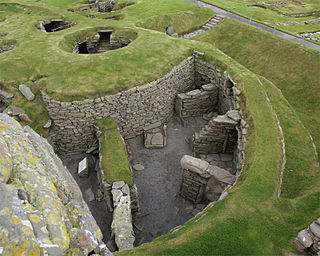
Prehistoric Shetland refers to a period in the human occupation of the Shetland archipelago of Scotland that was the latter part of these islands' prehistory. The period of prehistory prior to occupation by the genus Homo is part of the geology of Scotland. Although some written records refer to Shetland during the Roman invasions of Scotland, prehistory in Shetland does not end until the later part of the Early Historic Period in Scotland, around AD 900.

Brough Lodge is a 19th-century Gothic mansion on Fetlar, one of the Shetland Islands, in northern Scotland. Built by the Nicolson family, who were responsible for clearing Fetlar of many of its inhabitants, it has been disused since the 1980s. The Brough Lodge Trust has recently started work to restore the building. The house is protected as a category A listed building, and the grounds are included in the Inventory of Gardens and Designed Landscapes in Scotland, the national listing of significant gardens.
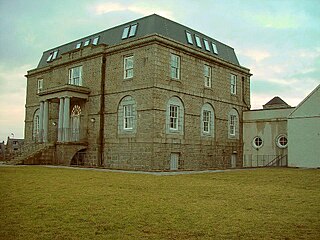
Symbister House is a former country house in Symbister, Whalsay island, in the Shetland islands of Scotland. It was built in 1823 by the Bruce family who were lairds (landlords) of the island for about 300 years from the 16th century. Since 1964 it has been the Whalsay Secondary School, after it fell into disuse following the death of the last of the landlord occupants of the house in 1944. Built in an elegant Georgian architectural style, it is categorized officially as a category B Listed Building and heritage structure.
The Pier House Museum is a museum in Symbister, Whalsay, in the Shetland Islands of Scotland. The museum is located in the old Pier House, which was once the centre for trade with the Germans and the export of dried and salted fish to the Hanseatic League, an alliance of trading guilds that established and maintained a trade monopoly over much of Northern Europe between the 13th and 17th centuries. The Germans brought their goods, iron tools, seeds, salt and cloth to barter for dried and salted fish from the island. The old Hanseatic house which had been used by the Germans for several centuries until 1707, was refurbished for the museum, housing artifacts which date from the earlier trading period and providing an important insight into the economy of the Shetlands at the time. Architecturally it is described as "two-storeyed with crowstepped gables, and an external stone staircase." The house and port nearby are categorized officially as a category B Listed Building.














